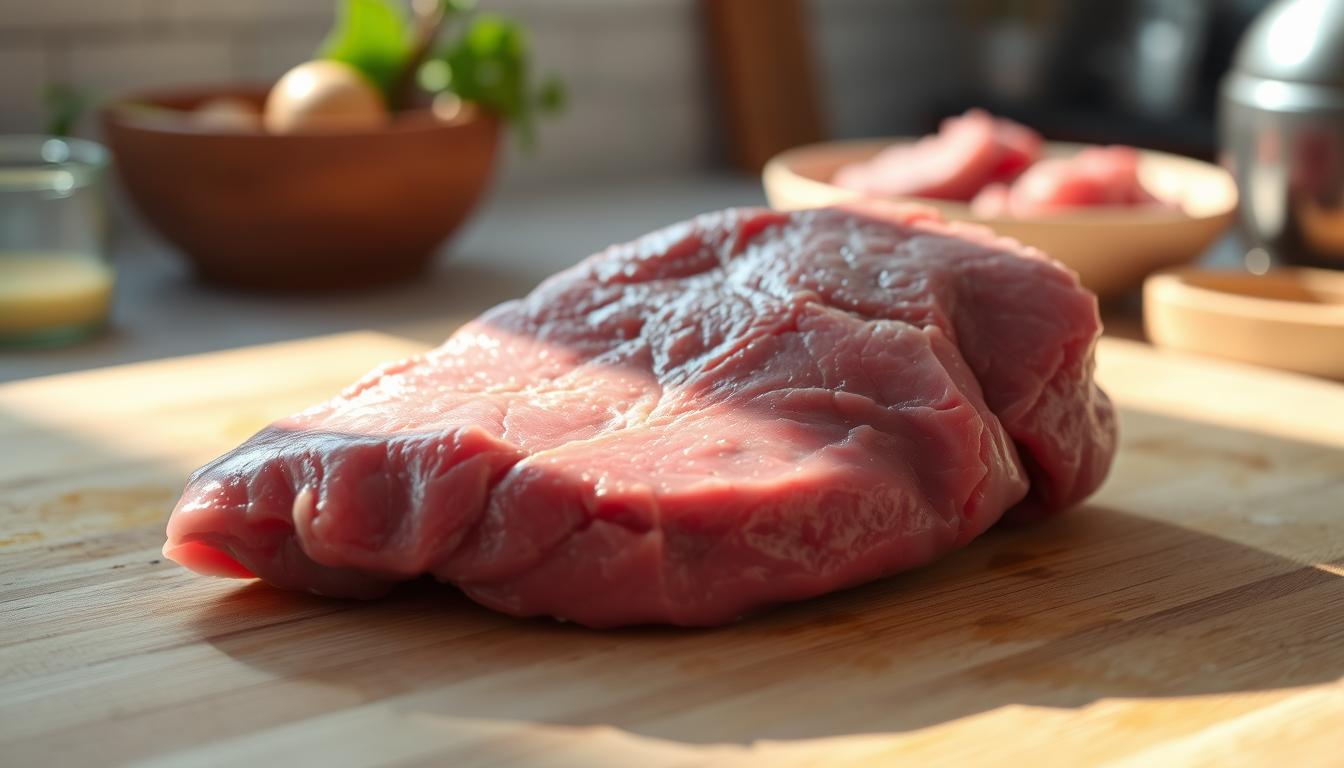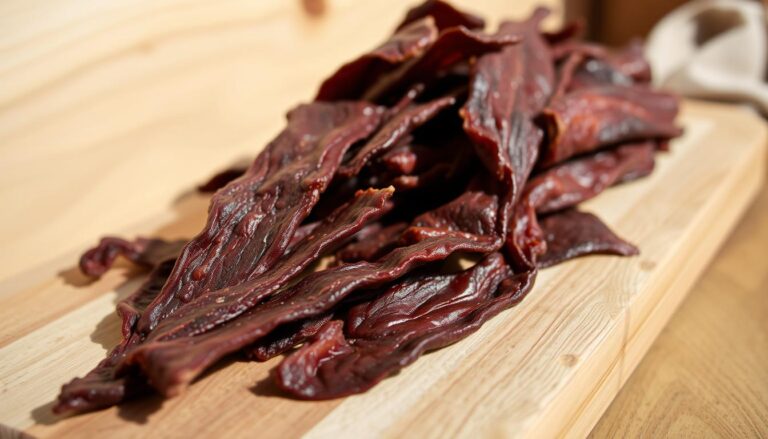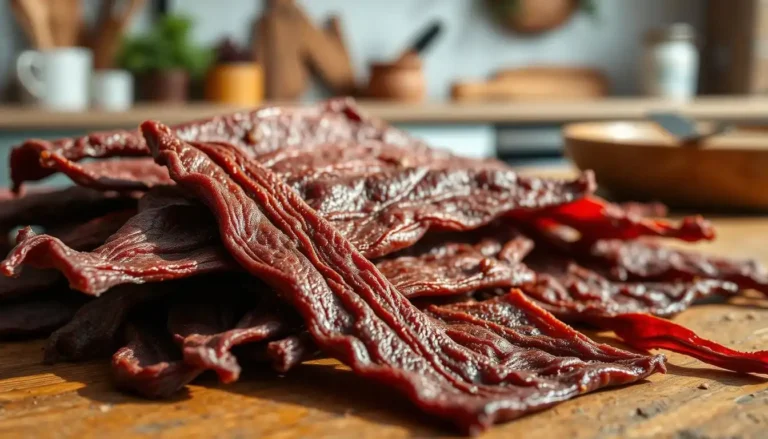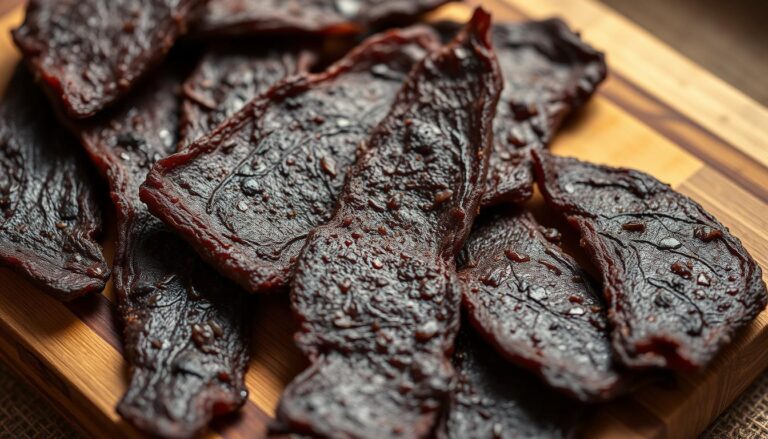Discover the best Surprising Beef Liver Benefits for Your Health
Have you ever wondered why organ meats were once a staple in traditional diets? Generations before us relied on nutrient-packed foods like beef liver for strength and vitality. Today, science confirms what our ancestors knew—this superfood is loaded with essential vitamins and minerals.
Just a small serving packs more protein than many muscle meats, along with sky-high levels of vitamin A and B12. Whether you’re an athlete or just health-conscious, adding this powerhouse to your diet can make a real difference.
But not all options are equal. Grass-fed varieties offer four times more nutrients than grain-fed, according to the Cleveland Clinic. And with proper cooking—reaching 160°F—it’s both safe and delicious.
Table of Contents
Discover the Surprising Beef Liver Benefits for Your Health
Key Takeaways
- Packed with protein—17g per 3oz serving
- Rich in vitamin A (104% DV) and B12 (2,917% DV)
- Grass-fed has 4x more nutrients than grain-fed
- Historically used by bodybuilders for muscle growth
- USDA organic ensures antibiotic-free quality
Introduction to Beef Liver Benefits
Modern diets often overlook a nutritional powerhouse hiding in plain sight. While muscle cuts like steak dominate plates, organ meats like liver deliver far more vitamins and minerals per bite. The Cleveland Clinic notes its dual role: a toxin filter and a storehouse of essential nutrients.
Globally, liver remains a staple in many cultures. From French foie gras to Jewish chopped liver, it’s celebrated for flavor and affordability. Yet in the West, consumption has dropped by 75% since the 1970s, per USDA data.
“The liver processes toxins but doesn’t store them—it’s packed with proteins and hormones vital for health.”
Here’s why savvy eaters are rediscovering it:
- Cost-effective: Half the price of sirloin per pound, with 10x the nutrients.
- Sustainable: Nose-to-tail eating reduces food waste.
- Versatile: Blends seamlessly into burgers or pâtés.
| Nutrient | Liver (3oz) | Chicken Breast (3oz) |
|---|---|---|
| Iron | 36% DV | 4% DV |
| Vitamin A | 104% DV | 0% DV |
| Protein | 17g | 26g |
Even picky eaters can enjoy it. Athletes grind it into shakes, while paleo dieters pan-fry it with onions. As Healthline confirms, it’s a complete protein, meaning all nine essential amino acids are present.
Nutritional Profile of Beef Liver
What if one food could deliver a week’s worth of nutrients in a single meal? A 3oz serving packs 149 calories, 23g of protein, and just 4g of fat—making it a lean, nutrient-dense choice. But the real magic lies in its vitamins and minerals, which outperform most supplements.
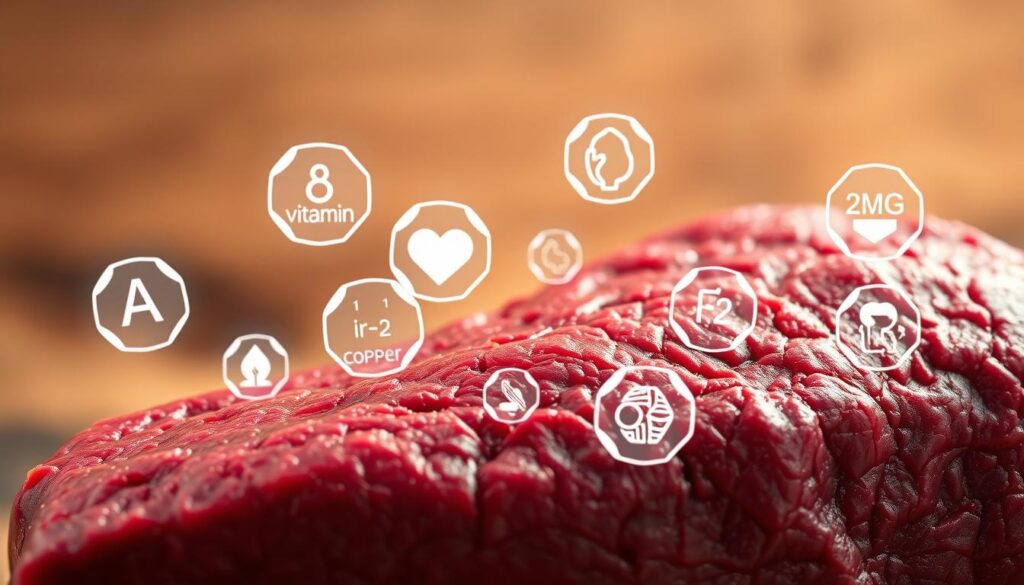
Vitamins and Minerals in Beef Liver
Vitamin A reigns supreme here, with 104% of your daily value (DV) per serving. It’s critical for retinal health and immune function. The B12 content is staggering—2,917% DV—supporting nerve cells and red blood production.
Copper levels are off the charts (1,578% DV), aiding iron absorption and energy metabolism. For context, kale provides just 10% of the copper found in a single serving. Even folate (63% DV) and riboflavin (261% DV) contribute to brain health and cellular repair.
“Liver’s heme iron is 3x more absorbable than plant-based iron, combating fatigue effectively.”
Protein Content and Quality
With 17g per 3oz, this protein source is complete, meaning it contains all nine essential amino acids. Unlike plant proteins, its bioavailability exceeds 90%, making it ideal for muscle repair.
Cholesterol content (310mg) may raise eyebrows, but research shows dietary cholesterol has minimal impact on blood levels for most people. Pair it with fiber-rich veggies to balance your meal.
| Nutrient | Beef Liver (3oz) | Spinach (3oz) |
|---|---|---|
| Vitamin A | 104% DV | 56% DV |
| Iron | 36% DV | 15% DV |
| Protein | 17g | 2g |
Top Health Benefits of Beef Liver
Your body craves nutrients that modern meals often miss—here’s how one superfood delivers. Packed with iron, vitamin A, and B vitamins, it supports everything from your energy levels to disease resistance.
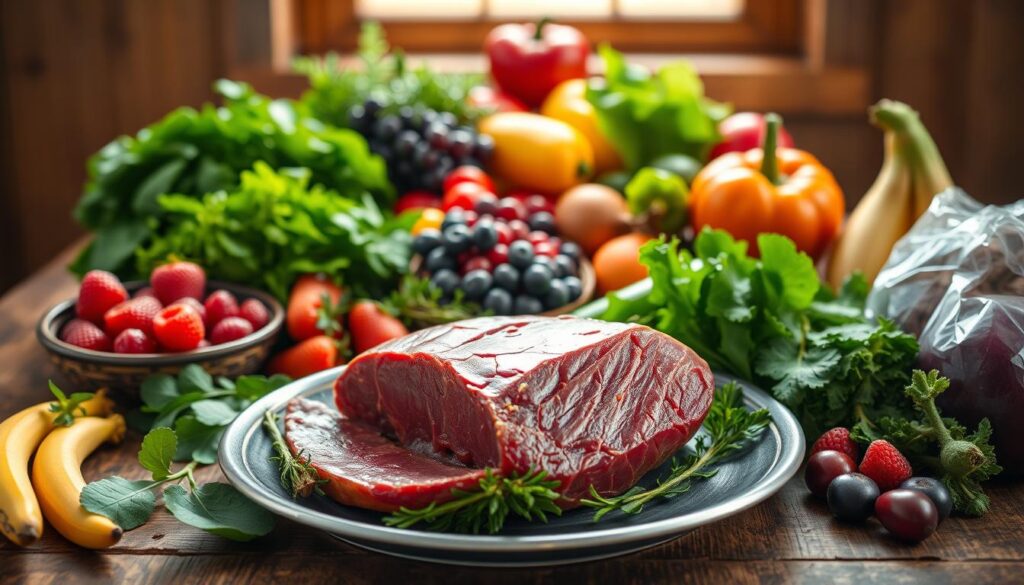
Iron: Your Blood’s Best Ally
A 3oz serving provides 4mg of iron—enough to prevent deficiency-related fatigue. This mineral fuels hemoglobin production, helping red blood cells transport oxygen. The Cleveland Clinic notes it’s especially absorbable, making it ideal for athletes or those with anemia.
“Heme iron from animal sources is three times more bioavailable than plant-based iron, optimizing energy metabolism.”
Vitamin A: Sharper Vision, Stronger Defenses
Retinol, the active form of vitamin A, maintains night vision and protects mucous membranes. WebMD links adequate intake to a lower breast cancer risk. But moderation matters—exceeding 3,000mcg RAE daily may cause toxicity.
B Vitamins: Fuel for Mind and Body
B12 (2,917% DV per serving) supports nerve function and red blood cell formation. Studies connect deficiencies to dementia risk. Riboflavin and folate further boost mitochondrial energy production, keeping your cells active.
- Satiety bonus: 17g of protein per serving curbs cravings for weight management.
- Workout recovery: Iron and B12 combined reduce post-exercise fatigue.
Comparing Grass-Fed vs. Grain-Fed Beef Liver
Not all animal products are created equal—especially when it comes to nutrient density. The Cleveland Clinic confirms grass-fed varieties contain four times more phytonutrients than grain-fed. This gap stems from diet: pasture-raised cattle eat diverse plants, while feedlot animals consume processed grains.
Omega-3 fatty acids are a key differentiator. Healthline notes grass-fed options offer a healthier omega-3:omega-6 ratio (1:2 vs. 1:7 in grain-fed). Balanced ratios reduce inflammation, lowering disease risk. Conjugated linoleic acid (CLA), a fat linked to heart health, is also 300% higher in pasture-raised liver.
“Grass-fed liver’s antioxidant levels—like carotenoids and tocopherols—outperform grain-fed by 50%, protecting cells from oxidative damage.”
Environmental impact matters too. Pasture-raised systems use fewer antibiotics, per a 2015 Consumer Reports study. Feedlots, however, may harbor antibiotic-resistant bacteria. USDA Organic certification ensures no synthetic pesticides or GMOs were used in feed.
| Factor | Grass-Fed | Grain-Fed |
|---|---|---|
| Omega-3s | High (1:2 ratio) | Low (1:7 ratio) |
| CLA | 300% more | Standard levels |
| Price | $12–$18/lb | $6–$10/lb |
When shopping, look for these labels:
- USDA Organic: Guarantees antibiotic-free, non-GMO feed.
- 100% Grass-Fed: No grain supplementation.
- Animal Welfare Approved: Ethical grazing practices.
Moderation is key. While grass-fed packs more nutrients, grain-fed remains a budget-friendly source. Rotate both for variety.
Potential Risks and Who Should Avoid Beef Liver
While nutrient-dense, liver isn’t for everyone—certain health conditions require caution. Its concentrated nutrients, like vitamin A and purines, may pose risks if overconsumed or for specific groups. Moderation and awareness are key.
Vitamin A Toxicity Concerns
A single 3oz serving exceeds the daily vitamin A limit for pregnant women (WebMD). Preformed vitamin A (retinol) accumulates in the body, unlike plant-based provitamin A. Chronic high intake may cause:
- Nausea or headaches
- Bone pain and fractures
- Liver damage (rare)
“NIH sets the upper limit at 3,000mcg RAE daily—exceeding this long-term increases risk of hypervitaminosis A.”
Those on Accutane or with disease affecting fat absorption (e.g., cystic fibrosis) should monitor levels closely.
Cholesterol and Purine Content
Lamb liver packs 436mg cholesterol per serving (WebMD). While dietary cholesterol has minimal impact for most, those with genetic predispositions (e.g., familial hypercholesterolemia) should limit intake.
Purines, which break down into uric acid, can trigger gout flares. Healthline notes high-purine foods like liver may worsen symptoms for susceptible people.
| Group | Risk Factor | Recommendation |
|---|---|---|
| Pregnant women | Birth defects from excess vitamin A | Limit to 1 serving/month |
| Gout patients | Purine conversion to uric acid | Avoid during flares |
| Wilson’s disease | Copper metabolism issues | Consult a doctor |
For most, 1–2 servings weekly is safe. Pair with fiber-rich veggies to balance nutrient absorption.
How to Incorporate Beef Liver into Your Diet
Transforming an underrated superfood into a kitchen staple is easier than you think. With simple prep tricks, even first-timers can enjoy its rich nutrients without overpowering tastes.
Delicious Cooking Methods
Soak slices in milk or lemon juice for 1–2 hours to mellow the metallic taste. The Cleveland Clinic recommends this step to improve palatability. Always cook to 160°F internally (USDA guideline) for safety.
For beginners, blending it with ground meat (1:4 ratio) masks the texture. Healthline notes this works well in burgers or meatballs. Pan-searing with garlic and *caramelized onions* adds depth.
“Low-and-slow cooking preserves tenderness, while high heat creates a crispy crust.”
Creative Recipe Ideas
- Pâté: Blend cooked liver with butter, herbs, and a splash of apple cider vinegar.
- Modern twist: Add diced liver to bacon-wrapped sliders for extra protein.
- Supplements: Capsules offer convenience, but fresh versions provide better absorption.
| Method | Time | Best For |
|---|---|---|
| Sautéing | 8–10 mins | Tender slices with onions |
| Blending | 5 mins | Smoothies or pâtés |
| Freezing | 30 mins pre-cook | Easier slicing |
Pair with acidic ingredients like balsamic glaze to cut richness. Enjoy in moderation—1–2 servings weekly balances nutrient intake.
Conclusion
Adding nutrient-rich organ meats to your meals can boost your health without breaking the bank. Just one weekly serving provides enough vitamin A, B12, and iron to support energy, immunity, and brain function.
While packed with nutrients, moderation matters. Those with specific conditions—like pregnancy or gout—should consult a nutritionist first. For others, it’s a budget-friendly source of essential vitamins often missing in modern diets.
Start small: mix it into familiar dishes or try supplements. Pair it with veggies for balanced absorption. Rediscover what traditional diets got right—efficient, sustainable eating that fuels your body well.
FAQ
Is beef liver high in nutrients?
Can eating beef liver improve energy levels?
How does beef liver support immune function?
Is grass-fed beef liver better than grain-fed?
Who should avoid or limit beef liver?
What’s the best way to cook beef liver to reduce bitterness?
How often should I eat beef liver?
For more cooking tips, stay connected with us. We also recommend the cookbook Skinnytaste Simple: Easy, Healthy Recipes with 7 Ingredients or Fewer
For more Recipes about Beef?
Did You try our recipe ?
There are no reviews yet. Be the first one to write one.
